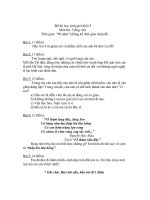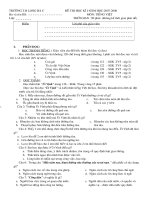- Trang chủ >>
- Mầm non - Tiểu học >>
- Lớp 5
5 2 2 holocaust rescuers (Scott Foresman)
Bạn đang xem bản rút gọn của tài liệu. Xem và tải ngay bản đầy đủ của tài liệu tại đây (4.3 MB, 14 trang )
Suggested levels for Guided Reading, DRA,™
Lexile,® and Reading Recovery™ are provided
in the Pearson Scott Foresman Leveling Guide.
Holocaust
Rescuers
by Gretchen McBride
Genre
Narrative
nonfiction
Comprehension
Skills and Strategy
• Author’s Purpose
• Generalize
• Monitor and Fix Up
Text Features
• Headings
• Captions
• Glossary
• Diagram
Scott Foresman Reading Street 5.2.2
ISBN 0-328-13521-6
ì<(sk$m)=bdfcbj< +^-Ä-U-Ä-U
Reader Response
Holocaust
Rescuers
1. Why do you think the author included information
about the Kindertransport? Use a graphic organizer
like the one below to identify words you thought of
when you read about Kindertransport.
by Gretchen McBride
Kindertransport
2. Raoul Wallenberg is remembered for saving the lives
of thousands of Jewish people. He is described on
page 17 as having used “any means he could” to save
their lives. What methods did he use? Why might it
have been unusual for a diplomat to use them?
3. Choose three words from the glossary that you did
not know the meanings of before reading the book.
Write each word in an interesting sentence.
4. Which photo captures your attention more than the
others? Why?
Editorial Offices: Glenview, Illinois • Parsippany, New Jersey • New York, New York
Sales Offices: Needham, Massachusetts • Duluth, Georgia • Glenview, Illinois
Coppell, Texas • Ontario, California • Mesa, Arizona
Adolf Hitler, shown
here in this calendar,
ruled Germany from
1933–1945.
Every effort has been made to secure permission and provide appropriate credit for
photographic material. The publisher deeply regrets any omission and pledges to
correct errors called to its attention in subsequent editions.
Unless otherwise acknowledged, all photographs are the property of Scott Foresman,
a division of Pearson Education.
Photo locators denoted as follows: Top (T), Center (C), Bottom (B), Left (L), Right (R),
Background (Bkgd)
Opener: United States Holocaust Museum; 1, 3, 4 United States Holocaust Museum;
5 Library of Congress; 6–8 ©DK Images; 9–21 United States Holocaust Museum;
22 ©DK Images; 23 ©DK Images
ISBN: 0-328-13521-6
Copyright © Pearson Education, Inc.
All Rights Reserved. Printed in the United States of America. This publication is
protected by Copyright, and permission should be obtained from the publisher
prior to any prohibited reproduction, storage in a retrieval system, or transmission
in any form by any means, electronic, mechanical, photocopying, recording, or
likewise. For information regarding permission(s), write to: Permissions Department,
Scott Foresman, 1900 East Lake Avenue, Glenview, Illinois 60025.
2 3 4 5 6 7 8 9 10 V0G1 14 13 12 11 10 09 08 07 06 05
Campaign of Hate
Adolf Hitler seized power in Germany in 1933. He
died in 1945. From 1933–1945, he carried out a brutal
plan to eliminate Europe’s Jewish people. Hitler and
his Nazi Party claimed that Jews were an “inferior
race.” He convinced many Germans that the Jews
were responsible for Germany’s economic problems.
Hitler was able to spread his message of hate
by holding huge rallies and giving speeches on the
radio. Radio provided an inexpensive way to reach
millions of people. Still, there were many people
who refused to believe Hitler and the Nazi Party’s
lies. Some of those people tried to save Jewish
people from the certain death that awaited them at
Nazi concentration camps.
3
The Holocaust
Holocaust means “complete destruction by fire.”
The word is used today to describe the Nazis’ plan to
wipe out Europe’s Jews.
About six million Jews died in the Holocaust. At
the same time, a like number of people of many
different beliefs and backgrounds were murdered.
The Holocaust destroyed lives, families, and whole
villages. It came close to ending Jewish life and
culture throughout all of Europe.
Did people know?
Life became harder for the Jewish people as soon
as Hitler took power. Many were taken from their
homes and forced into ghettos. These ghettos were
areas of cities cut off from the rest of the people.
The ghettos were crowded and dirty. The Jewish
people were not allowed to leave them. But soon
the Nazis came up with a “final solution” to the
“Jewish question.” They sent the Jewish people to
concentration camps to be killed.
People in the United States suspected that
something was happening to the Jewish people in
Europe. But there was no proof of the Holocaust
until 1942. In that year the United States government
received a cable from representatives of the World
Jewish Congress in Switzerland. The cable revealed
that Hitler was planning to kill millions of Jewish
people in Europe.
American President
Franklin Roosevelt
learned about the
Holocaust in 1942.
The Jewish population was
concentrated, or brought
together in one place, at
concentration camps such as
the one above.
4
5
You might be wondering why the Jews did not
leave as soon as Hitler took power. There are several
reasons. First, they had no idea of the horror that
was to come. The Nazis kept their plans secret. That
helped prevent the Jews from fighting back. Most
people did not want to leave their homes. It is scary
to leave everything behind in order to start a new
life somewhere else. The Jewish people did not want
to be refugees. However, as things got worse, many
of them tried to get out of Europe.
Symbols of the Jewish
faith such as these were
destroyed wherever the
Nazis went.
It was not easy for the Jews to leave. Jewish
families often had to leave their money behind when
they left. The Nazis stamped Jews’ passports with
the letter “J” so they would be questioned by other
countries’ officials. Jews also needed a visa. A visa is
a pass that allows people to enter a country. Many
countries would issue only a few visas per year.
Did non-Jewish Europeans know what was
happening to their Jewish friends and neighbors?
Many people did not know how bad the situation
was. Others knew that terrible things were
happening but did nothing to help. Still, there were
a few very brave people who did what
they could to help the Jewish people.
You will learn about some of those
people later in this book.
The Nazis forced the Jewish
people to wear the Star of
David on their clothing so
everyone could tell that
they were Jews.
6
7
Into Hiding
A small number of Jewish people went into hiding
in Germany and the other countries that the Nazis
took over. Of them, a young girl named Anne Frank,
became the most famous. You may have read The
Diary of Anne Frank. It tells the story of Frank’s years
spent hiding in the attic of a Dutch office building. The
Nazis found Anne and her family. She did not survive.
Anne Frank and her
family hid in the
attic of the building
shown in this
cutaway diagram.
There were other Jewish children and adults
who were hidden by non-Jewish people. Jews were
hidden in attics, cellars, and other places. The people
who hid them shared their own food, which during
the war was often hard to find.
Some Jewish people tried to “hide in plain
sight.” This meant they continued to go out in
public. However, they hid their Jewish identity. They
removed the yellow Star of David that the Nazis
made them wear. By doing so they hoped to blend
in more. But as “illegals” they could not buy food.
This caused many Jewish people to starve to death.
Many of those who
hid were captured
and killed. Often
the people who
protected them were
also killed. And yet
some Jewish people
escaped because
brave people helped
them.
Between the ages of
thirteen and fifteen,
Anne Frank kept a diary
and wrote short stories,
essays, and fairy tales.
She even began a novel.
8
9
Kristallnacht opened the
world’s eyes to the horror
unfolding in Nazi Germany.
Kindertransport: Children’s Transport
November 9, 1938, was a turning point for Nazi
Germany. On that night the Nazis smashed the
windows of Jewish homes and businesses throughout
Germany. That night is now known as Kristallnacht
(KRIS-tahl-nahkt). In English it is often called the
“Night of Broken Glass.” Kristallnacht alerted the
world to the danger facing the Jews of Europe.
People realized that something had to be done to
help the Jewish children trapped in Germany.
After Kristallnacht, groups in Britain asked their
government to change the laws so that more Jewish
children from Germany could enter the country.
Ten thousand children managed to get to Britain.
Seventy-five hundred of them were Jewish.
10
The Kindertransport saved
many Jewish children from
certain death.
Children who were homeless, orphaned, or had
parents in concentration camps were the first to get
visas. But only children who had found people to
pay their living costs in Britain were issued visas. The
rescue effort was called Kindertransport. The word
meant “children’s transport.”
The children traveled by train and then by ship
to Britain. Upon arriving in Britain some went to
live with foster families. Others were housed in
hotels and on farms. The rescuers who organized
the Kindertransport hoped that the children would
rejoin their parents after the war. But when the war
ended an awful truth was revealed. Almost all of
their parents had died in concentration camps. After
the war the children became citizens of Great Britain,
Israel, the United States, Canada, and Australia.
11
Emergency Rescue Committee:
Varian Fry
In 1940 a group of New Yorkers formed the
Emergency Rescue Committee (ERC). The ERC was
concerned about the safety of Jewish writers, artists,
and educators. Many of them had fled to France
before the war. But then the Nazis conquered most
of France in May 1940. The Nazis’ control of France
placed these Jews in danger. The ERC responded by
deciding to try a secret rescue mission.
The journalist Varian Fry was sent by the ERC to
Marseille (mahr-SAY). Marseille was located in a part
of France that was not directly ruled by the Germans.
Fry opened an office in Marseille. He pretended
that he was running a charity. In reality Fry used
the office to help Jewish people escape to safety.
The French government soon became suspicious
of Fry. They made him leave France in 1941. But in
just thirteen months,
Varian Fry had
helped more than
two thousand people
leave Nazi-occupied
France. Among them
were some of the
most famous artists
and thinkers of the
twentieth century.
Varian Fry (above) saved
almost two thousand Jews
during World War II by setting
up a pretend charity fund in
Marseille, France (left).
12
13
Le Chambon-sur-Lignon
The French village of Le Chambon-sur-Lignon
(ler shahm-BOHN ser lin-YOHN) gave shelter to
Jews during the war. The people of the village were
mainly Protestant Christians. This made them a
minority in France, where most people were Catholic
Christians. As minorities the Protestants sympathized
with the Jews and wanted to help them.
Andre Trocme, a church pastor, urged the people
to give aid to their Jewish neighbors. The people
responded by allowing Jews to hide in their homes.
Other Jews were given shelter by Catholic Christians
in Catholic buildings near the village. The villagers
also helped some Jews obtain fake visas to enter
Switzerland. Switzerland was not involved in the
war. That made it safer for Jews to live there.
The people of Le Chambon-sur-Lignon did not
feel that they were doing anything heroic. They
simply made an agreement with Pastor Trocme to do
the right thing. In doing so, they helped almost five
thousand Jewish people survive the Holocaust.
A postcard from 1942 (left)
showing a children’s home in
Le Chambon-sur-Lignon.
Refugee children with their
guardian (below) outside
of a children’s home in Le
Chambon-sur-Lignon.
14
15
Raoul Wallenberg, Heroic Diplomat
More than anyone else, Raoul Wallenberg is
remembered for having saved Jewish people from
the Holocaust. Wallenberg was born in Sweden in
1912. He came from a wealthy family. In 1935 he
graduated from the University of Michigan with a
degree in architecture. Wallenberg had difficulty
finding architectural work in Sweden. So he went
to work in Palestine (now Israel). There he met Jews
who had escaped from Nazi Germany.
In 1944 the United States established the War
Refugee Board (WRB) to help save Jewish people.
The WRB’s representative in Sweden brought
together a group of people who wanted to organize
a rescue mission in
Budapest, Hungary.
The group asked
Wallenberg to lead
the rescue mission.
He accepted and
became a diplomat.
At the time, the Nazis were losing control of
Hungary to the Russian army. The Russians were
taking over very quickly. So the Nazis worked as
fast as they could to deport Hungary’s Jews to
concentration camps. Raoul Wallenberg felt there
was no time to follow the usual rules of diplomacy.
He used any means he could to save Jewish people.
The people who worked under Wallenberg issued
thousands of protective passes. Wallenberg also
had “Swedish houses” built in the city. He used his
position to declare the houses Swedish territory. Jews
were safe at the “Swedish houses” because Sweden,
like Switzerland, was neutral. That meant it wasn’t
involved in the war. Soon diplomats from other
neutral countries followed Wallenberg’s example.
Jewish people going to one of
Wallenberg’s “Swedish houses”
in Budapest
Raoul Wallenberg
17
The Nazis would fill train cars with Jewish
people to take them away to concentration camps.
Wallenberg climbed onto the tops of the train cars
and passed protective passes to the people inside
them. He then would jump to the ground and
demand that the people with passes be released.
The guards had orders from their superiors to shoot
Wallenberg. But they were so impressed by his
amazing courage that they allowed him to escape
unharmed.
In January 1945 the Nazis planned to kill the
last remaining Jews of Budapest’s largest Jewish
ghetto. At this point, it was clear that Germany
would be defeated. Raoul Wallenberg threatened
the general who had been ordered to carry out
the killings. Wallenberg said that if the order were
carried out, he would have the general executed as a
war criminal following Germany’s defeat. Thanks to
Wallenberg’s brave threats, the people of the ghetto
were saved at the last minute.
When the Soviet troops marched into Hungary,
Wallenberg asked permission to visit their military
headquarters. He was never seen again. Wallenberg’s
fate is unknown.
Nevertheless this
courageous man was
able to save as many
as 100,000 Jewish
people from the Nazi
concentration camps.
The Nazis transported
people to concentration
camps on freight trains
such as this one, shown
after the war ended.
18
19
The Danes
The Nazis occupied Denmark during most of
World War II. Despite the occupation, many Danes
refused to help the Nazis murder the Jews. A
courageous German diplomat, Georg Ferdinand
Duckwitz, secretly told the Danes
that the Nazis were about
to deport all of the Jewish
citizens of Denmark. The
Danes acted quickly.
They hid some Jewish
people. They helped
others leave the
country. For two
weeks, Danish
fishermen ferried
Jewish people across
the water to Sweden.
This was a nationwide
effort. More than
seven thousand Jewish
Danes were saved.
A Jewish family from Denmark
shares Christmas dinner with
a Christian family in Sweden.
The Danes saved approximately
seven thousand Jewish people
during World War II.
Georg Ferdinand Duckwitz
This Danish fishing boat
was used to rescue Jewish
refugees. It is on display at the
Holocaust Memorial Museum
in Washington, D.C.
20
21
Remembering: Yad Vashem
The Hebrew phrase yad vashem can be translated
as “a monument and a memorial.” The Israeli
government founded Yad Vashem to help preserve
the memory of Holocaust victims. The organization
is in charge of many museums, libraries, memorials,
and monuments. Yad Vashem’s Avenue and Garden
of the Righteous Among the Nations, in Jerusalem,
Israel, honors the non-Jewish people who risked
their own lives to save Jews during the Holocaust.
This Holocaust memorial
sculpture (below) is located in
Berlin, Germany.
The Hall of Remembrance
(below) is found in the
Holocaust Memorial Museum
in Washington, D.C.
22
23
Reader Response
Glossary
agreement n. an
understanding between
people, groups, or
nations.
cable n. a message sent
through wires by electric
current or electronic
signals.
diplomat n. someone who
manages the relations
between his or her nation
and other nations.
issue v. to send out; put
forth.
refugees n. people who
flee for refuge or safety.
representatives n. people
appointed or elected to
speak for others.
superiors n. people of
higher position, rank, or
ability.
visa n. an official
signature or endorsement
upon a passport.
1. Why do you think the author included information
about the Kindertransport? Use a graphic organizer
like the one below to identify words you thought of
when you read about Kindertransport.
Kindertransport
2. Raoul Wallenberg is remembered for saving the lives
of thousands of Jewish people. He is described on
page 17 as having used “any means he could” to save
their lives. What methods did he use? Why might it
have been unusual for a diplomat to use them?
3. Choose three words from the glossary that you did
not know the meanings of before reading the book.
Write each word in an interesting sentence.
4. Which photo captures your attention more than the
others? Why?
24
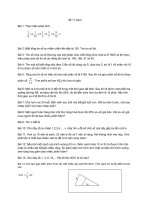

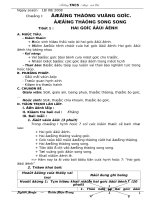

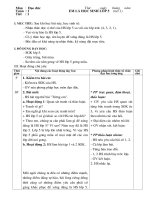

![Ke chuyen Lop 5[2].ppt](https://media.store123doc.com/images/document/13/pt/ev/medium_evu1372525566.jpg)
